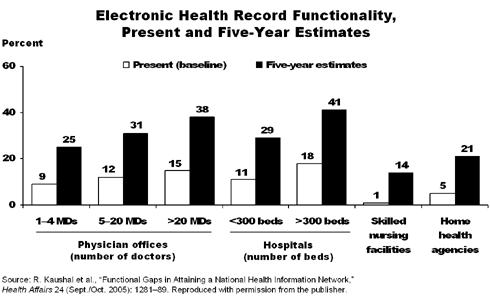For other Fund publications about health information technology (IT), visit our Health IT Resources page.
In the Literature
Information technology (IT) has great potential to improve the safety and quality of medical care, but the adoption of health IT has been slow. Five years from now, how far will the nation's health IT network have progressed?
According to the study, "Functional Gaps in Attaining a National Health Information Network" (Health Affairs, Sept./Oct. 2005), financial and personnel constraints will cause smaller providers, such as home health agencies and skilled nursing facilities, to lag behind larger ones. Still, the researchers say that implementation of such technologies as electronic health record (EHR) and computerized physician order entry (CPOE) technologies will likely triple or quadruple in the next five years.
The study, which was supported by The Commonwealth Fund and the Harvard Interfaculty Program for Health Systems Improvement, was led by Rainu Kaushal, M.D., M.P.H., of Brigham and Women's Hospital in Boston.
Developing a Model National Health Information Network
Kaushal and colleagues convened an expert panel to develop a model national health information network (NHIN) that would be attainable in five years, taking into account financial, personnel, and technical constraints. The panel agreed that such a network should include electronic viewing of test results, electronic health records (EHRs), computerized physician order entry (CPOE), electronic claims submission, electronic eligibility verification, secure online patient communication, and electronic prescription acceptance by pharmacies. The network should span physician offices, hospitals, skilled nursing facilities, home health agencies, clinical laboratories, and pharmacies.
Next, the team estimated the current levels of adoption of these IT systems, drawing on interviews with stakeholders in two markets and their own estimates. They then measured the gaps between the functionalities of the model NHIN and the expected functionalities in five years based on the current rate of IT adoption.
Administrative Tools Expected to Be Widely Adopted
In five years, the team predicts that administrative functionality, such as electronic claims submission and eligibility checks, will be furthest advanced, while clinical functionalities are likely to lag further behind. This gap, the researchers say, is due to the fact that there are clear incentives for providers to adopt administrative capabilities, like reducing costs and decreasing turnaround time for bills.
Result-viewing capability is expected to be the most widely adopted clinical functionality, as it is easily integrated into existing work processes and provides great benefit to users. The panel projected that, in five years, such functionality would be developed in 51 percent to 69 percent of office practices and 70 percent to 83 percent of hospitals.
The study estimates that the implementation of EHR and CPOE functionality will likely triple or quadruple in the next five years. Electronic health record functionality will increase from 9 percent to 25 percent in small physician practices (one to four physicians), and from 15 percent to 38 percent in larger practices (more than 20 physicians). Computerized physician order entry functionality will increase from 5 percent to 21 percent in small practices, and from 9 percent to 32 percent in larger practices.
In general, size matters: large stakeholders, such as hospitals, are expected to have the most clinical functionalities in five years, followed by smaller hospitals and then large, medium, and small office practices. Smaller stakeholders, such as home health agencies and skilled nursing facilities, are expected to have the least developed clinical IT.
Policy Recommendations
The authors note that if adoption of health IT among smaller stakeholders lags behind, continuity of care will be impaired as patients move from highly computerized inpatient settings to paper-based outpatient settings. Policy intervention, the researchers say, should preferentially target adoption by smaller stakeholders to prevent such inequities. In addition, health purchasers and third-party payers can create pay-for-performance incentives to encourage health IT adoption. Stakeholders with smaller operating budgets may require direct financial assistance.
Finally, creating an NHIN will require developing and adopting standards to ensure interoperability of systems and addressing privacy and security issues, the authors say.
Facts and Figures:
- Based on current trends, secure patient communication systems will be available in 33 to 46 percent of office practices in five years.
- Computerized physician order entry is estimated to be more prevalent than electronic health records (EHRs) in the inpatient setting.
- Only 21 percent of home health agencies and 14 percent of skilled nursing facilities are expected to have an EHR system.
- More than one-half (58%) of pharmacies will be able to accept electronic prescriptions in five years, the panel estimated.



